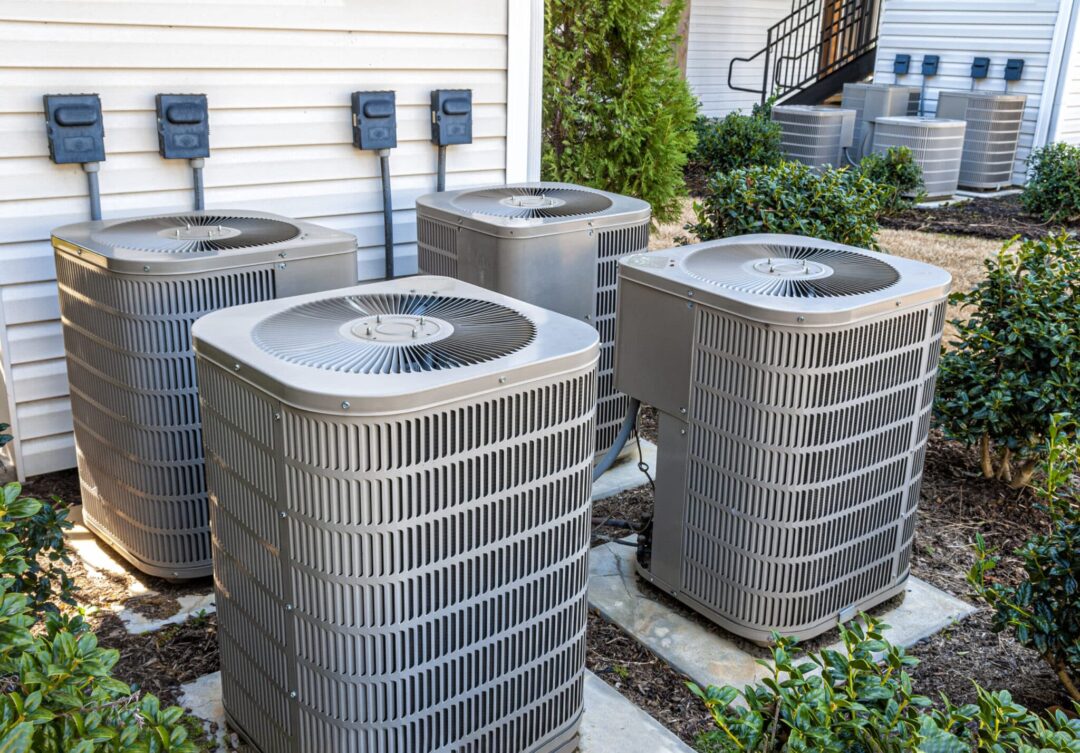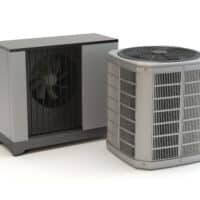Parts of Residential HVAC Systems: A Must Read Guide

Have you ever wondered how your home stays comfortable regardless of the weather outside?
Understanding the parts of residential HVAC systems is crucial in maintaining a cozy and efficient living space. This article will delve into the intricacies of HVAC systems, helping you become more informed about the equipment that plays a vital role in your home’s comfort.
In this article, we’ll explore the various components of residential HVAC systems, their functions, and why they’re important for your home’s heating, ventilation, and air conditioning.
Whether you’re a new homeowner or looking to enhance your knowledge, this guide will provide valuable insights into your HVAC system’s workings.

What are Parts of Residential HVAC Systems?
The parts of residential HVAC systems are crucial for maintaining a comfortable and efficient home environment. These components include the thermostat, which acts as the system’s control center, the furnace for heating, and the air conditioner for cooling.
Ductwork plays a vital role in distributing air throughout your home, while the heat pump offers an energy-efficient alternative for both heating and cooling.
Indoor and outdoor units work in tandem to regulate your home’s climate, with the evaporator coil and condenser coil playing key roles in the heat exchange process.
The compressor (one of the parts of residential HVAC systems) is essential for the refrigeration cycle, moving refrigerant between the coils and altering its pressure to facilitate heat absorption and release.
Air filters (one of the parts of residential HVAC systems) are indispensable for maintaining indoor air quality, trapping particles and contaminants before they circulate through your living spaces.
Vents and registers allow the controlled distribution of conditioned air, while the expansion valve adjusts refrigerant flow to meet cooling demands.
The blower motor ensures consistent air circulation, and zoning systems can provide customized temperature control across different areas of your home.
Additionally, depending on your local climate and specific needs, your HVAC systems might include a humidifier or dehumidifier to maintain optimal indoor humidity levels, enhancing comfort and preventing issues related to overly dry or moist air.
Understanding these parts of residential HVAC systems and their functions can empower you as a homeowner, enabling you to make informed decisions about maintenance, upgrades, and energy efficiency, ultimately leading to a more comfortable, healthier, and cost-effective living environment.
A Detailed Explanation of Residential HVAC Systems Components
Residential HVAC systems are complex assemblies that ensure your home’s air is fresh, clean, and at a comfortable temperature.
Let’s break down the key components and understand their roles in maintaining your home’s comfort.
Parts of Residential HVAC Systems #1: The Thermostat: Your HVAC’s Brain
Understanding the Thermostat’s Role
The thermostat is one of the pivotal parts of residential HVAC systems, serving as the brain behind your home’s heating and cooling.
It continuously monitors the indoor temperature, making real-time decisions to maintain your desired comfort levels. This intelligent device can initiate or halt the heating or cooling process, ensuring your living environment remains consistent with your preferences.
Modern Thermostat Advancements
With advancements in technology, modern thermostats go beyond basic temperature regulation.
Programmable thermostats allow you to set temperature schedules, adapting your home’s climate to your daily routine, enhancing both comfort and energy efficiency.
These smart devices can learn your habits over time, making automatic adjustments to save energy while ensuring your home is comfortable when you’re there.
Energy Efficiency and User Convenience
Energy efficiency is a significant benefit of contemporary thermostats. By optimizing your heating and cooling patterns, these devices can significantly reduce unnecessary energy consumption, leading to lower utility bills.
Additionally, many modern thermostats offer remote control via smartphones or computers, allowing you to adjust your home’s temperature from anywhere, adding a layer of convenience to your busy life.
Integration with parts of residential HVAC systems
The thermostat’s ability to communicate with other parts of residential HVAC systems, like the furnace, and air conditioner, and even parts of residential HVAC systems like zoning systems, is crucial.
This integration ensures that each component operates in harmony, providing efficient and effective temperature regulation throughout your home.
By understanding the thermostat’s role and capabilities, you can better appreciate how this device contributes to the overall functionality and efficiency of your HVAC system, ensuring your home remains a comfortable sanctuary regardless of the season.
Parts of Residential HVAC Systems #2: The Furnace: The Heart of Heating
Central Role of the Furnace in Home Heating
The furnace stands as the heart of your home’s heating system, playing a crucial role in maintaining warmth and comfort.
As a central component of the parts of residential HVAC systems, it generates heat by burning fuel or using electrical resistance, depending on the type of furnace you have. This generated heat is then transferred to the air, which is circulated throughout your home to maintain a cozy atmosphere during colder months.
Fuel Source Variability and Efficiency
Furnaces can operate on a variety of fuel sources, including natural gas, oil, or electricity, each with its own set of benefits and considerations.
Natural gas furnaces are popular for their efficiency and lower operating costs, while oil furnaces are often used in areas where natural gas is not readily available.
Electric furnaces, on the other hand, provide an alternative that’s often preferred for their simplicity and safety, though they can be more expensive to operate due to higher electricity costs.
Integration with HVAC Systems Components
The efficiency of a furnace is not just about its performance but also how well it integrates with other parts of residential HVAC systems.
The ductwork, for instance, is essential for distributing the heated air throughout your home. Ensuring that the furnace and ductwork are properly sized and in good condition is vital for optimal heating efficiency and home comfort.
Advanced Features and Technologies
Modern furnaces come equipped with advanced features such as variable speed blowers and modulating gas valves, which enhance the system’s efficiency by adjusting the heat output and airflow based on the actual heating needs of your home.
These features not only improve comfort by providing more consistent heat but also contribute to energy savings by reducing wasted energy.
By understanding the importance of the furnace in your residential HVAC systems, you can appreciate its role in ensuring your home remains warm and inviting, especially during the chillier seasons.
Regular maintenance and understanding the compatibility of your furnace with other HVAC components can lead to enhanced efficiency and prolonged system life.
Parts of Residential HVAC Systems #3: The Air Conditioner: Keeping You Cool
The Fundamental Role of the Air Conditioner
The air conditioner is a cornerstone in the realm of residential HVAC systems, tasked with the critical role of mitigating heat and humidity within your home.
This system operates on the principles of refrigeration, extracting warm indoor air, cooling it through a series of processes, and then recirculating the chilled air back into your living spaces. This cycle is pivotal in maintaining a serene and cool environment, especially during the sweltering summer months.
How Air Conditioners Enhance Home Comfort
Air conditioners do more than just lower the temperature; they also play a crucial role in reducing indoor humidity levels.
High humidity can make indoor environments feel uncomfortably warm and can contribute to the growth of mold and mildew.
By removing excess moisture from the air, air conditioners help create a more comfortable and healthier living environment, enhancing the overall quality of life within your home.
Energy Efficiency and Technological Advancements
Modern air conditioners are equipped with advanced technologies that boost their efficiency and reduce their environmental impact.
Features like programmable thermostats, energy-efficient compressors, and improved refrigerants are designed to maximize cooling efficiency while minimizing energy consumption.
These advancements not only contribute to a more sustainable planet but also lead to significant savings on energy bills for homeowners.
Integration with Residential HVAC Systems
The effectiveness of an air conditioner is significantly influenced by its integration with other components of the residential HVAC system.
Proper installation, regular maintenance, and seamless operation with elements like ductwork and air filters are essential for optimal performance. Ensuring that the entire system is well-coordinated allows for efficient cooling and prolongs the lifespan of the air conditioning unit.
Understanding the vital role of the air conditioner in your residential HVAC systems empowers you to make informed decisions about its maintenance and operation.
Regular care and awareness of its function within the broader system can lead to enhanced comfort, improved air quality, and greater energy efficiency in your home.
Parts of Residential HVAC Systems #3: Ductwork: The Circulatory System
Essential Role of Ductwork in HVAC Systems
Ductwork serves as the circulatory system of your home’s HVAC setup, playing a pivotal role in distributing conditioned air throughout your living spaces. This network of tubes, akin to veins and arteries in the human body, ensures that heated or cooled air reaches every corner of your home, maintaining a consistent and comfortable indoor climate.
The efficiency and effectiveness of your HVAC system are heavily reliant on the design, installation, and maintenance of this crucial component.
Design and Installation: Foundations of Efficiency
The design and installation of ductwork are foundational to the optimal performance of your HVAC systems.
Properly sized and strategically laid-out ducts ensure balanced air distribution, preventing issues like uneven heating or cooling and excessive strain on your HVAC equipment.
Professional design considers factors like the size of your home, the number of rooms, and the specific heating and cooling requirements to create a ductwork layout that maximizes efficiency and comfort.
The Importance of Sealing and Insulation
Sealing and insulating ducts are critical practices that prevent air leaks and minimize thermal loss, respectively.
Leaks in ductwork can lead to significant energy waste, as conditioned air escapes into unoccupied spaces like attics or crawl spaces instead of reaching intended areas.
Insulation helps maintain the temperature of the air as it travels through ducts, especially in unconditioned spaces, enhancing overall system efficiency and reducing energy costs.
Regular Maintenance for Optimal Performance
Regular maintenance, including inspections, cleaning, and repairs, is vital for keeping ductwork in top condition. Over time, ducts can accumulate dust and debris, which can hinder airflow and degrade air quality.
Periodic checks can identify and rectify issues like leaks, blockages, or damage, ensuring that your HVAC systems operate at their best, providing consistent comfort while minimizing energy consumption.
Understanding the critical role and maintenance needs of ductwork in your residential HVAC systems allows you to ensure its longevity and efficiency. A well-designed, properly sealed, and regularly maintained ductwork network is key to achieving optimal performance from your HVAC system, ensuring your home remains a comfortable sanctuary year-round.
Parts of Residential HVAC Systems #4: The Heat Pump: A Versatile Alternative
Heat Pumps: Dual-Function Efficiency
Heat pumps stand out as a versatile and energy-efficient alternative within the parts of residential HVAC systems, capable of providing both heating and cooling solutions.
Unlike traditional furnaces or air conditioners that generate heat or cool air, heat pumps transfer heat to or from your home, depending on the season. This process of moving heat rather than generating it makes heat pumps an environmentally friendly and cost-effective option for maintaining indoor comfort.
How Heat Pumps Operate
In the cooler months, heat pumps extract warmth from the outside air or ground, even in cold temperatures, and transfer it indoors to heat your home.
Conversely, during warmer periods, they reverse this process, removing heat from your home and releasing it outdoors, effectively cooling your living spaces. This dual functionality makes heat pumps a singular solution for year-round climate control, reducing the need for separate heating and cooling systems.
Energy Efficiency and Environmental Impact
The efficiency of heat pumps is measured by their Coefficient of Performance (COP) for heating and their Seasonal Energy Efficiency Ratio (SEER) for cooling.
High COP and SEER ratings indicate a more efficient unit, leading to lower energy consumption and reduced utility bills.
Moreover, by utilizing electricity and minimizing the burning of fossil fuels, heat pumps contribute to a reduction in greenhouse gas emissions, aligning with eco-friendly living principles.
Integration with Residential HVAC Systems
Integrating a heat pump into your residential HVAC systems can enhance overall efficiency and comfort.
When paired with components like thermostats and ductwork, heat pumps can provide precise temperature control and distribution throughout your home.
Additionally, modern heat pumps can be equipped with features like variable speed compressors and advanced air filtration, further improving energy efficiency and indoor air quality.
Understanding the role and benefits of heat pumps in residential HVAC systems allows homeowners to make informed decisions about their heating and cooling options.
With their ability to provide efficient, year-round climate control, heat pumps represent a smart investment for those seeking a sustainable and cost-effective solution to their home comfort needs.
Parts of Residential HVAC Systems #5: Indoor and Outdoor Units
The Synergy of Indoor and Outdoor Units
In the realm of split-system HVAC configurations, the collaboration between indoor and outdoor units is fundamental to achieving a comfortable home environment.
This partnership is essential in the parts of residential HVAC systems, where the indoor unit, typically hosting the furnace and evaporator coil, works in tandem with the outdoor unit, which houses the condenser and compressor.
Together, they form a cohesive system that efficiently regulates your home’s temperature, regardless of the season.
Role of the Indoor Unit
The indoor unit plays a critical role in the HVAC systems by managing air quality and temperature within your home.
The furnace within the indoor unit is responsible for heating, while the evaporator coil works in conjunction with the air conditioner or heat pump to cool the indoor air. This unit also includes a fan that circulates air through the ducts, ensuring consistent temperature distribution throughout your living spaces.
Functionality of the Outdoor Unit
The outdoor unit’s primary function is to facilitate the heat exchange process essential for cooling and in the case of heat pumps, heating.
The condenser coil releases or absorbs heat from the outside air, while the compressor modulates the refrigerant flow, enabling the system to maintain the desired indoor temperature.
The outdoor unit’s efficient operation is crucial for the overall performance and energy efficiency of the HVAC system.
Ensuring Optimal Performance
For the parts of residential HVAC systems to function effectively, both indoor and outdoor units must be properly maintained and synchronized.
Regular maintenance, including cleaning and inspections, ensures that each component operates at peak efficiency, reducing energy consumption and preventing costly repairs.
Additionally, ensuring that both units are correctly sized and matched can significantly enhance the system’s overall efficiency and longevity.
Understanding the collaborative roles of indoor and outdoor units in a residential HVAC system empowers homeowners to make informed decisions about their heating and cooling needs.
This knowledge is crucial for maintaining an efficient, effective, and reliable HVAC system that provides consistent comfort throughout the year.
Parts of Residential HVAC Systems #6: The Evaporator Coil: Where Cooling Begins
Central Role in the Cooling Process
The evaporator coil is a crucial component in the cooling cycle of your HVAC system, playing a pivotal role in the parts of residential HVAC systems.
Located within the indoor unit, typically in the air handler or attached to the furnace, this coil is where the refrigerant absorbs heat from the indoor air, initiating the cooling process.
As air passes over the chilled coils, the refrigerant inside absorbs heat, effectively lowering the air temperature and removing excess humidity.
How the Evaporator Coil Functions
When your air conditioner or heat pump is in cooling mode, the refrigerant inside the evaporator coil undergoes a phase change from liquid to gas, absorbing heat in the process.
This phase change is essential for extracting heat from the indoor air, contributing to the overall cooling effect.
The coil’s design maximizes the surface area in contact with the air, enhancing the heat exchange efficiency and ensuring effective cooling and dehumidification.
Impact on Indoor Comfort and Air Quality
The evaporator coil’s ability to remove heat and humidity from the indoor air is vital for maintaining comfortable and healthy living conditions.
By reducing humidity levels, the coil helps prevent the growth of mold and mildew, contributing to better indoor air quality. Additionally, the cooling provided by the evaporator coil ensures that your home remains a comfortable refuge from the outdoor heat.
Maintenance for Optimal Performance
Regular maintenance of the evaporator coil is essential for sustaining its efficiency and prolonging the lifespan of your parts of residential HVAC system.
Over time, the coil can accumulate dust and debris, which can impede airflow and reduce the system’s cooling capacity. Professional cleaning and routine inspections can prevent these issues, ensuring that your HVAC system continues to provide effective cooling and humidity control.
Understanding the function and importance of the evaporator coil in your residential HVAC system is key to optimizing your home’s comfort and air quality.
Proper care and maintenance of this component can lead to enhanced cooling performance, improved energy efficiency, and a longer-lasting HVAC system.
Also read: Residential HVAC Installation: Essential Tips for Homeowners
Parts of Residential HVAC Systems #7: The Condenser Coil
Integral Component in Heat Dissipation
The condenser coil, situated in the outdoor unit of your HVAC system, is instrumental in expelling the heat absorbed from your home’s interior. This coil is a vital part of the parts of residential HVAC systems, ensuring the efficiency of the cooling cycle by releasing the accumulated heat into the external environment.
Its function is pivotal in re-establishing and maintaining a cool and comfortable indoor atmosphere, especially during the warmer months.
The Heat Release Process
When the refrigerant, now warmed by the indoor heat absorption, reaches the condenser coil, it is in a gaseous state.
The outdoor unit’s fan expels outdoor air across the condenser coil, facilitating the transfer of heat from the refrigerant to the outside air.
This process cools the refrigerant, which then condenses back into a liquid form, ready to cycle back to the evaporator coil and absorb more indoor heat, thus continuing the cooling process.
Enhancing System Efficiency
The efficiency of the condenser coil is crucial for the overall energy efficiency of the HVAC systems.
A clean and well-maintained coil ensures optimal heat release, reducing the system’s workload and, consequently, energy consumption. Any obstruction or damage to the coil can hinder this process, leading to increased energy use and potentially higher utility bills.
Regular Maintenance for Optimal Performance
To ensure the condenser coil (one of the parts of residential HVAC systems) functions effectively, regular maintenance is essential. This includes cleaning the coil to remove debris, dust, or leaves that can block airflow and reduce efficiency.
Professional inspections can also identify any potential issues, such as refrigerant leaks or coil damage, that could impair the system’s performance and longevity.
Understanding the role and maintenance needs of the condenser coil in your residential HVAC systems is key to optimizing its performance and efficiency.
Proper care of this component helps maintain your home’s comfort while minimizing energy costs, ensuring your system operates effectively for years to come.
Parts of Residential HVAC Systems #8: The Compressor
Central Role in Refrigerant Circulation
The compressor, often referred to as the heart of the cooling system, plays an indispensable role in the operation of your HVAC system.
Located in the outdoor unit, it is responsible for circulating refrigerant between the evaporator and condenser coils, a critical process in the heat exchange mechanism that underpins your system’s cooling capabilities.
This component’s efficient functioning is vital for the effective operation of the parts of residential HVAC systems, ensuring a consistent and comfortable indoor climate.
How the Compressor Works
The compressor initiates its role by drawing in the low-pressure, gaseous refrigerant from the evaporator coil.
It then compresses this gas, increasing its pressure and temperature, and propels it towards the condenser coil. This process is fundamental to the refrigeration cycle, enabling the refrigerant to release the absorbed heat when it reaches the condenser coil.
The transformation of the refrigerant’s state and pressure is what drives the cooling cycle, making the compressor a critical component in maintaining your home’s comfort.
Impact on System Efficiency
The efficiency of the compressor (one of the parts of residential HVAC systems) directly influences the overall energy efficiency of the HVAC system.
An optimally functioning compressor ensures that the refrigerant is effectively circulated and the heat exchange process is maximized, leading to reduced energy consumption and lower utility bills.
Conversely, a malfunctioning compressor can lead to decreased efficiency, increased energy costs, and potential system breakdowns.
Maintenance for Reliability and Longevity
Regular maintenance and timely repairs are crucial for the compressor’s longevity and the HVAC system’s reliability.
Ensuring that the compressor is in good working condition involves regular inspections, proper lubrication, and prompt attention to any signs of wear or malfunction. Professional HVAC technicians can assess and address any issues, ensuring that the compressor, and consequently the entire system, operates efficiently and effectively.
Understanding the compressor’s role and maintenance needs within your residential HVAC system is essential for ensuring optimal performance and extending the lifespan of your system.
Proper care of these parts of residential HVAC systems helps maintain a comfortable indoor environment and contributes to the system’s energy efficiency and reliability.
Parts of Residential HVAC Systems #9: Air Filters
Vital Role in Air Quality Maintenance
Air filters are essential components in the parts of residential HVAC systems, serving a critical function in maintaining indoor air quality.
Positioned within the airflow of your system, these filters capture and hold various airborne particles, such as dust, pollen, pet dander, and other allergens, preventing them from recirculating through your home.
By doing so, air filters play a pivotal role in ensuring the air you breathe is clean, contributing significantly to the overall health and comfort of your living environment.
Types of Air Filters and Their Efficiency
There are a variety of air filters available, each designed to capture different types of particles with varying degrees of efficiency. These range from basic fiberglass filters, which capture larger particles, to more advanced HEPA filters, which can trap much smaller particles, improving the air quality further.
The efficiency of an air filter is typically measured by its MERV (Minimum Efficiency Reporting Value) rating, which indicates how effectively it can remove particles from the air.
Impact on HVAC System Performance
Beyond improving air quality, air filters ( one of the parts of residential HVAC systems) also protect the HVAC system itself. By trapping debris, filters prevent particles from entering the system, where they can cause wear and tear on components like the blower motor and evaporator coil.
Regularly changing or cleaning air filters can prevent airflow restrictions, maintain system efficiency, and extend the lifespan of the HVAC systems.
Maintenance for Optimal Air Quality
To ensure the best performance from your HVAC systems and maintain high indoor air quality, it’s crucial to replace or clean air filters regularly.
The frequency depends on the filter type, your home’s air quality, and your household’s specific needs, such as allergies or pets. Regularly checking and adhering to the manufacturer’s recommendations can help you determine the appropriate maintenance schedule.
Understanding the importance of air filters in your residential HVAC systems highlights their role in not only preserving the system’s efficiency and longevity but also in ensuring a healthier and more comfortable home environment.
Proper maintenance of these filters is a simple yet effective way to enhance your indoor air quality and HVAC system performance.
Parts of Residential HVAC System #10: Vents and Registers
Essential Components for Air Distribution
Vents and registers play a crucial role in the parts of residential HVAC systems, acting as the final delivery points for conditioned air into your home’s living spaces.
These components are strategically located throughout your home to ensure an even and effective distribution of heated or cooled air, facilitating optimal temperature control and enhancing overall comfort.
Differentiating Vents and Registers
While the terms are often used interchangeably, there is a subtle difference between vents and registers in an HVAC context.
Vents are the broader category, referring to any opening through which air is delivered or returned to the HVAC systems.
Registers, on the other hand, are specific types of vents that come with adjustable louvers, allowing you to control the direction and volume of airflow into a room. This adjustability is key to managing room-by-room comfort and optimizing the efficiency of your HVAC systems.
Impact on HVAC Efficiency and Comfort
Properly placed and functioning vents and registers are vital for maintaining balanced air pressure and ensuring efficient system operation.
They allow for the customization of airflow in different areas, addressing unique heating and cooling needs and preventing issues like hot or cold spots in your home.
Additionally, ensuring that vents and registers are not blocked by furniture, curtains, or other obstacles is crucial for maintaining unimpeded air circulation, which is essential for both system efficiency and indoor air quality.
Maintenance and Optimization
Regular cleaning and inspection of vents and registers (one of the parts of residential HVAC systems) can prevent dust buildup and ensure they are operating correctly. This maintenance not only contributes to a cleaner indoor environment but also supports the overall performance of your HVAC systems.
In some cases, adjusting the louvers or redirecting airflow can enhance room comfort without the need for adjusting the thermostat, leading to energy savings.
Understanding the role of vents and registers in your residential HVAC system underscores their importance in achieving efficient air distribution and maintaining a comfortable and healthy home environment.
Proper care and strategic use of these components can significantly enhance the effectiveness of your heating and cooling system.
Parts of Residential HVAC Systems #11: The Blower Motor
The Driving Force Behind Air Movement
The blower motor is a pivotal component in the parts of residential HVAC systems, serving as the driving force that circulates air throughout your home.
Located in the furnace or air handler, this motor powers the fan that moves heated or cooled air through the ductwork, ensuring that every room reaches the desired temperature. Its efficient operation is crucial for maintaining consistent comfort and optimal air quality in your living spaces.
Types and Efficiency of Blower Motors
Blower motors come in various types, each with different efficiency levels and control capabilities.
Traditional single-speed motors operate at full capacity whenever they’re on, while multi-speed and variable-speed motors offer greater flexibility and efficiency.
Variable-speed motors, in particular, can adjust their speed to the system’s needs, providing more precise temperature control, reduced energy consumption, and quieter operation.
Impact on HVAC System Performance
The blower motor’s performance has a direct impact on the HVAC system’s efficiency and the overall comfort in your home.
An effectively functioning blower motor ensures that air is evenly distributed throughout the house, eliminating hot or cold spots and facilitating consistent temperature control.
Additionally, it plays a vital role in air filtration, as it ensures that air continuously passes through the filters, removing contaminants and improving indoor air quality.
Maintenance for Longevity and Efficiency
Regular maintenance of the blower motor is essential to ensure its longevity and the efficient operation of your HVAC systems. This includes periodic inspections, cleaning of components, and timely repairs if issues arise.
Keeping the blower motor (one of the parts of residential HVAC systems) in good condition helps prevent system breakdowns, extends the life of your HVAC systems, and ensures that your home remains a comfortable sanctuary.
Understanding the importance of the blower motor in your residential HVAC system highlights its role in ensuring effective air circulation and maintaining a comfortable and healthy indoor environment.
Proper care and maintenance of this component can significantly enhance your system’s performance and your home’s overall comfort.
Here’s everything else you need to know about maintaining and optimizing your HVAC systems for peak performance and efficiency.
Top 5 Strategies for Enhancing Residential HVAC Systems
Retrofit Old HVAC Systems
Upgrading parts of residential HVAC systems, such as the compressor or integrating air-side economizers, can significantly boost its energy efficiency. This retrofitting process not only makes your system more eco-friendly but also extends its operational lifespan, providing a cost-effective alternative to complete system replacement.
By focusing on strategic upgrades, you can enhance the parts of residential HVAC systems, ensuring they work more efficiently and effectively.
Invest in Energy-Efficient HVAC Systems
When the time comes to replace your HVAC system, choosing a unit with a high SEER (Seasonal Energy Efficiency Ratio) rating and Energy Star certification is crucial.
Such systems are designed to use less energy while maintaining optimal performance, leading to considerable savings on utility bills and a reduced environmental footprint.
Investing in these advanced systems contributes to a sustainable future while ensuring your parts of residential HVAC systems are working well year-round.
Enhance Insulation
Proper insulation is a key factor in preventing energy loss in residential HVAC systems.
By insulating your home and the ductwork effectively, you minimize the escape of conditioned air, allowing your HVAC system to operate more efficiently.
This not only improves the system’s performance but also contributes to consistent indoor temperatures and reduced energy consumption, highlighting the importance of insulation in the overall efficiency of your HVAC system.
Utilize Aeroseal Duct Sealing
A common issue that affects HVAC efficiency is duct leakage.
By sealing your ductwork with Aeroseal, you can prevent conditioned air from escaping, ensuring that it is delivered effectively throughout your home.
This process enhances the parts of residential HVAC systems, optimizing air distribution and improving energy efficiency, which can lead to significant cost savings and a more comfortable living environment.
Install Programmable Thermostats
Incorporating programmable or smart thermostats into your HVAC system allows for automated temperature adjustments based on your daily schedule.
This technology reduces energy consumption when you’re not home and ensures comfort when you are, making it a smart investment for both convenience and efficiency. By adapting to your lifestyle, programmable thermostats offer a simple yet effective way to enhance the energy efficiency of your residential HVAC system.
Implementing these strategies can significantly improve the efficiency and effectiveness of your residential HVAC system, leading to enhanced comfort, reduced energy bills, and a smaller carbon footprint.

One Hour Air Conditioning & Heating of Phoenix, AZ: Your HVAC Systems Partner
Expert Solutions for Your HVAC Needs
One Hour Air Conditioning & Heating of Phoenix, AZ, is a trusted provider of HVAC services, offering comprehensive solutions for all components of your residential HVAC system.
Whether you need routine maintenance, emergency repairs, or a complete system overhaul, their team of skilled professionals is equipped to ensure your home’s heating, cooling, and air quality systems are operating efficiently and effectively.
Serving the Greater Phoenix Area
With a focus on the Phoenix metro area, including Scottsdale, Paradise Valley, Chandler, Mesa, and Tempe, One Hour Air Conditioning & Heating extends its top-notch services to a broad range of locations.
Their local expertise means they’re familiar with the specific HVAC needs and challenges of each community, ensuring tailored solutions that address the unique aspects of your home’s environment.

Why Choose One Hour Air Conditioning & Heating?
Choosing One Hour Air Conditioning & Heating means opting for reliability, expertise, and customer-focused service.
Their commitment to timely and professional service is reflected in their name, emphasizing their dedication to resolving your HVAC issues within a reasonable timeframe.
By partnering with them, you gain access to a team that’s not only knowledgeable about the parts of residential HVAC systems but also committed to enhancing the comfort and efficiency of your home.
Connect with One Hour Air Conditioning & Heating
Ready to improve your home’s HVAC system?
Contact One Hour Air Conditioning & Heating at 480-508-8881 or visit their Google My Business page to explore reviews and ratings from satisfied customers in the Phoenix area. Take the first step towards a more comfortable and efficient home today.
Conclusion
Understanding and maintaining the parts of residential HVAC systems is crucial for ensuring a comfortable, efficient, and healthy living environment.
From the essential components like the thermostat, furnace, air conditioner, and ductwork to the supportive elements like the blower motor and air filters, each part plays a vital role in the system’s overall functionality.
Implementing energy-saving strategies, such as retrofitting old systems, investing in energy-efficient units, enhancing insulation, utilizing Aeroseal duct sealing, and installing programmable thermostats, can significantly improve your system’s performance while reducing energy costs.
For residents in Phoenix, AZ, and surrounding areas like Scottsdale, Paradise Valley, Chandler, Mesa, and Tempe, One Hour Air Conditioning & Heating offers expert services to address all your HVAC needs, ensuring your system operates at its best.
Remember, a well-maintained HVAC system not only contributes to your home’s comfort and air quality but also to your well-being and peace of mind.

FAQS
-
How often should I replace the air filters in my HVAC systems?
It’s generally recommended to change them every 90 days, but this can vary based on factors like pet ownership, allergies, and the specific filter type. Check your filter monthly and replace it if it appears dirty.
-
What are the signs that my HVAC system needs maintenance or repair?
Indicators that your HVAC system may need attention include unusual noises, inconsistent temperatures, increased energy bills, and poor air quality.
-
Can a programmable thermostat really save me money on my energy bills?
Yes, programmable thermostats can lead to significant energy savings by allowing you to set temperature schedules that align with your lifestyle, ensuring you’re not heating or cooling your home unnecessarily when you’re away or asleep.
-
What is the importance of SEER ratings in HVAC systems?
The Seasonal Energy Efficiency Ratio (SEER) rating measures the cooling efficiency of your air conditioner or heat pump. A higher SEER rating indicates greater efficiency, which translates to lower energy consumption and reduced utility bills.
-
How can Aeroseal duct sealing improve my HVAC system’s performance?
Aeroseal duct sealing effectively seals leaks within your ductwork, preventing air loss and improving system efficiency.
This ensures that heated or cooled air is delivered where it’s needed, enhancing comfort, improving air quality, and reducing energy costs.







